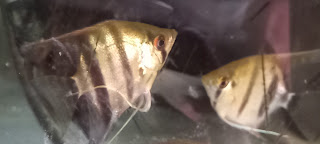Angel Fish Breeding: A Comprehensive Guide
Angel fish, with their elegant appearance and graceful movements, are popular choices for aquarium enthusiasts. Breeding these majestic creatures can be a rewarding experience, but it requires careful planning, attention to detail, and patience. In this guide, we will walk you through the essential steps to successfully breed angel fish in your own aquarium.
Understanding Angel Fish Behavior
Before attempting to breed angel fish, it's crucial to understand their behavior and requirements. Angel fish are known to be relatively peaceful, but they can become territorial, especially during breeding. It's essential to provide them with adequate space and hiding spots to reduce aggression.
Setting Up the Breeding Tank
To encourage breeding behavior, you'll need to create an environment that mimics their natural habitat. Here's how to set up the breeding tank:
1. Tank Size : A breeding tank should be at least 20 gallons in size to provide enough space for the breeding pair and potential fry.
2. Water Conditions : Angel fish prefer slightly acidic to neutral water with a pH range of 6.5 to 7.5. Keep the water temperature between 78 to 82°F (25 to 28°C).
3. Filtration and Aeration : Install a gentle filtration system to maintain water quality without creating too much water flow, as strong currents can stress the fish. Aeration is also important to ensure adequate oxygen levels.
4. Substrate and Décor : Use fine gravel or sand as substrate and add plants and decorations to provide hiding places for the fish. Live plants like Java moss and Amazon swords can also help mimic their natural habitat and provide spawning surfaces.
Selecting Breeding Pair:
Choose a healthy breeding pair with vibrant colors and no signs of illness or deformities. It's best to select a pair that has already formed a bond or introduce them gradually in a separate tank to allow them to establish their territory.
Conditioning the Breeding Pair:
Before spawning, it's essential to condition the breeding pair by providing them with a varied diet rich in protein. Offer live or frozen foods such as bloodworms, brine shrimp, and high-quality pellets to enhance their reproductive readiness.
Inducing Spawning:
Once the pair is well-conditioned, you can induce spawning by gradually raising the water temperature by a few degrees and increasing the frequency and volume of water changes. Additionally, providing a flat surface like a piece of slate or a broad leaf for the eggs to adhere to can stimulate spawning behavior.
Caring for the Eggs and Fry:
After spawning, the male and female angel fish will take turns guarding the eggs. It's essential to monitor the water conditions closely and maintain pristine water quality to prevent fungal or bacterial infections. The eggs usually hatch within 48 to 72 hours, and the fry will become free-swimming after another 5 to 7 days.
Rearing the Fry:
Once the fry become free-swimming, you can start feeding them with infusoria, freshly hatched brine shrimp, or commercial fry food. Gradually transition them to larger food particles as they grow. Provide frequent water changes to keep the water clean and ensure optimal growth.
Breeding angel fish can be a fulfilling endeavor for aquarium enthusiasts, but it requires dedication and attention to detail. By understanding their behavior, providing an appropriate breeding environment, and caring for the fry, you can successfully breed and raise healthy angel fish in your own aquarium. Remember to be patient and enjoy the fascinating process of observing these beautiful creatures reproduce and grow.

Comments
Post a Comment